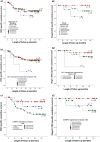Combination of laser microdissection, 2D-DIGE and MALDI-TOF MS to identify protein biomarkers to predict colorectal cancer spread
- PMID: 30679934
- PMCID: PMC6341757
- DOI: 10.1186/s12014-019-9223-7
Combination of laser microdissection, 2D-DIGE and MALDI-TOF MS to identify protein biomarkers to predict colorectal cancer spread
Abstract
Biomarkers are urgently required to support current histological staging to provide additional accuracy in stratifying colorectal cancer (CRC) patients according to risk of spread to properly assign adjuvant chemotherapy after surgery. Chemotherapy is given to patients with stage III to reduce the risk of recurrence but is controversial in stage II patients. Up to 25% of stage II patients will relapse within 5 years after tumor removal and when this occurs cure is seldom possible. The aim of this study was to identify protein biomarkers to stratify risk of spread of CRC patients. Laser micro-dissection was used to isolate cancer cells from primary colorectal tumors of stage II patients which did or did not metastasize within 5 years after surgical resection. Protein expression differences between two groups of tumors were profiled by 2D-DIGE with saturation CyDye labeling and identified using MALDI-TOF mass spectrometry. Evaluation of protein candidates was conducted using tissue micro array (TMA) immunohistochemistry on 125 colorectal tumor tissue samples of different stages. A total of 55 differentially expressed proteins were identified. Ten protein biomarkers were chosen based on p value and ratio between non metastasized and metastazised groups and evaluated on 125 tissues using TMA immunohistochemistry. Expression of HLAB, protein 14-3-3β, LTBP3, ADAMTS2, JAG2 and NME2 on tumour cells was significantly associated with clinical parameters related to tumour progression, invasion and metastasis. Kaplan-Meier survival curve showed strong expression of six proteins was associated with good CRC specific survival. Expression of HLAB, ADAMTS2, LTBP3, JAG2 and NME2 on tumour cells, was associated with tumour progression and invasion, metastasis and CRC specific survival may serve as potential biomarkers to stratify CRC patients into low and high risk of tumour metastasis. Combined methods of laser microdissection, 2D DIGE with saturation labelling and MALDI-TOF MS proved to be resourceful techniques capable of identifying protein biomarkers to predict risk of spread of CRC to liver.
Keywords: Biomarkers; Colorectal cancer; Liver metastasis; Prognosis; Proteomics.
Figures




Similar articles
-
New prognosis biomarkers identified by dynamic proteomic analysis of colorectal cancer.Mol Biosyst. 2012 Nov;8(11):3077-88. doi: 10.1039/c2mb25286d. Epub 2012 Sep 20. Mol Biosyst. 2012. PMID: 22996014
-
Identification of Differentially Expressed Proteins in the Serum of Colorectal Cancer Patients Using 2D-DIGE Proteomics Analysis.Pathol Oncol Res. 2016 Jan;22(1):169-77. doi: 10.1007/s12253-015-9991-y. Pathol Oncol Res. 2016. PMID: 26463353 Free PMC article. Clinical Trial.
-
Identification and Construction of Combinatory Cancer Hallmark-Based Gene Signature Sets to Predict Recurrence and Chemotherapy Benefit in Stage II Colorectal Cancer.JAMA Oncol. 2016 Jan;2(1):37-45. doi: 10.1001/jamaoncol.2015.3413. JAMA Oncol. 2016. PMID: 26502222
-
MicroRNAs in the prognosis and therapy of colorectal cancer: From bench to bedside.World J Gastroenterol. 2018 Jul 21;24(27):2949-2973. doi: 10.3748/wjg.v24.i27.2949. World J Gastroenterol. 2018. PMID: 30038463 Free PMC article. Review.
-
Tissue proteomics for cancer biomarker development: laser microdissection and 2D-DIGE.BMB Rep. 2008 Sep 30;41(9):626-34. doi: 10.5483/bmbrep.2008.41.9.626. BMB Rep. 2008. PMID: 18823585 Review.
Cited by
-
Systems-level biomarkers identification and drug repositioning in colorectal cancer.World J Gastrointest Oncol. 2021 Jul 15;13(7):638-661. doi: 10.4251/wjgo.v13.i7.638. World J Gastrointest Oncol. 2021. PMID: 34322194 Free PMC article. Review.
-
Identification of DNA methylation biomarkers for risk of liver metastasis in early-stage colorectal cancer.Clin Epigenetics. 2021 Jun 9;13(1):126. doi: 10.1186/s13148-021-01108-3. Clin Epigenetics. 2021. PMID: 34108011 Free PMC article.
-
The ideal reporting of RAS testing in colorectal adenocarcinoma: a pathologists' perspective.Pathologica. 2023 Jun 14;115(3):137-47. doi: 10.32074/1591-951X-895. Online ahead of print. Pathologica. 2023. PMID: 37314870 Free PMC article. Review.
-
Identification of Diagnostic Exosomal LncRNA-miRNA-mRNA Biomarkers in Colorectal Cancer Based on the ceRNA Network.Pathol Oncol Res. 2022 Sep 16;28:1610493. doi: 10.3389/pore.2022.1610493. eCollection 2022. Pathol Oncol Res. 2022. PMID: 36185995 Free PMC article.
-
Prognostic Values for the mRNA Expression of the ADAMTS Family of Genes in Gastric Cancer.J Oncol. 2020 Aug 20;2020:9431560. doi: 10.1155/2020/9431560. eCollection 2020. J Oncol. 2020. PMID: 32884571 Free PMC article.
References
LinkOut - more resources
Full Text Sources
Research Materials
Miscellaneous
